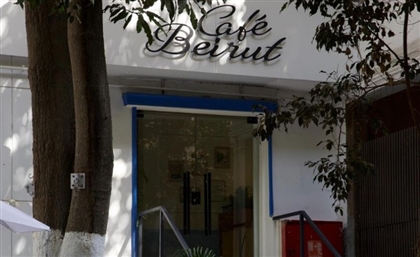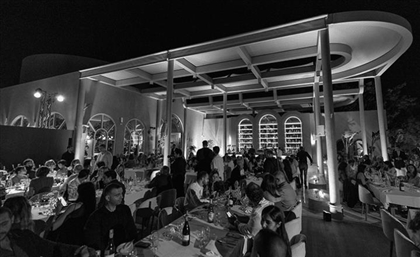Chickpea Garlands: Diving into the Rich History of a Blessed Legume
Did you know just how blessed the humble chickpea is?

Every year, in October, Tanta experiences a celebration of chickpeas, where hundreds of pilgrims from all over the region flock to the city to consume blessing-infused treats, and stock up on their legumes for a blessed year. The celebration, originally purely a religious pursuit, has since grown to signify a deeper history to the humble chickpea.
Think about what happens when you first sit down at a dining table to eat. The first step, typically, is to thank the power that made the food before you available - God. The intertwinement of food, religion and culture has long been present in dining rooms, celebrations and even at the fruit market. In fact, in our culture, food is often synonymous with ‘rizq’ - blessings. In Tanta, the yearly celebration of Sheikh Al-Badawi’s mulid makes for a more explicit celebration of the blessings of Egypt’s forgotten Sufi sheikh - in chickpeas.
For hundreds of years, Tanta was a destination for one of the biggest celebrations of mulids in Egypt, celebrating the birth of Sheikh Ahmed Al-Badawi, then nicknamed ‘Sheikh Al Arab’ by the people of Tanta. Originally born in Fez Morocco, the ascetic Al-Badawi journeyed through Makkah and eventually chose to settle in Tanta, Egypt, where he is annually commemorated and fondly remembered by the people of the city.
-4d14852c-22b3-42d0-b87c-2287f573196a.jpg)
Every year, from October 6th to the 12th, Tanta locals - as well as pilgrims, Sufi and otherwise, from all over the world - gather around the Al-Badawi mosque in Tanta to celebrate the legacy of Sheikh Al Arab. The Sheikh was famous for a legacy of generosity, which explains why pilgrims use the mulid as an opportunity to speak about their worries and ask for blessings from his burial place and mosque, although it is common for pilgrims to visit the mosque in search of help all year round.
As is the case with many mulids all over the country, the celebration lasts multiple days, and on the great and final night, even lasts all night, where people get to engage in all sorts of enjoyable activities ‘baraka’ of the Sheikh, which are described in the essay ‘Eating and Fasting for God in Sufi Tradition’ by Valerie Hoffman. “The celebration may last as long as two or three weeks, with ever more activity building to a fever pitch on the last, "great night." People come to the mulids to visit the tomb of the saint, partake of the baraka of the mulid, and perhaps to enjoy the many pleasures set up by merchants for the mulids: booths selling special toys, mini amusement parks, shooting games, roasted chick-peas, and the like.”
Throughout the entire week, and particularly on the “great night,” it is important for pilgrims to partake in the Sheikh’s blessing in every way possible. To the locals, that is in the form of offering their unlimited hospitality to fellow pilgrims. Hoffman elaborates, “The offering of hospitality, especially food and drink, which is fundamental to traditional Arab culture, has been elevated to the status of a sacred act. It is an act of piety that has come to define the Sufi lifestyle for many.”
In Sheikh Al Arab’s mulid, the celebration is decorated with roasted chickpeas, hummus, which local producers look forward to preparing all year ahead of the mulid. These chickpeas are perceived to hold the blessings of Sheikh Al-Badawi, and taking them signifies taking his ‘baraka’.
-42b942d7-eac0-4059-8690-2e041be35053.jpg)
“For pilgrims, who regularly attended these festivals, the mulid, baraka, and consumption of treats were essential parts of their religious practice,” explains Stephanie Boyle in her essay ‘The Role of Chickpeas at the Festival (Mulid) of Ahmad al-Badawi in the Egyptian Delta 1850s to 1890s’. “For believers, consuming treats was not only part of the festivities, but a spiritual connection that brought the individual closer to God through (the wali) Ahmad al-Badawi.”
Throughout the years, however, religious celebrations as well as the legitimateness of Sufism became subject to question, and their practitioners were ostracised.
As the founder of the Sufi order of Badawiyya (otherwise known as Ahmadiyya), Sheikh Al Arab’s popularity quickly became limited in the Egyptian scope. While the sheikh did preach conventionally Islamic values, such as compassion, intercession and patience, his lack of attachment to a strict doctrine placed him outside the normalcy of Islamic orthodoxy and consequently, to an extent, alienated his religious merit. With the emergence of the Islamic reform movement in the 18th century, Sufism was pushed to the side, and the celebrations of Sheikh Al Arab’s legacy became looked down upon.
In his article ‘Hidden or Forbidden, Elected or Rejected: Sufism as ‘Islamic Esotericism’?’, Simon Sorgenfrei attributes the rejection of Sufism to “the tendency to equate [it] with esoteric and heterodox beliefs and so-called un-Islamic practices.” This is largely a result of Muslims’ efforts to attune Muslim practices to the “normal” view of religion in Western countries, primarily Catholicism. “The proponents of Islamic reforms were concerned with what they conceived as the stagnation of Muslim cultures in relation to European civilizations, which had colonised and, in their view, humiliated Muslims.”

After reaching its maximum popularity in the Mamluk and Ottoman periods in Egypt, and then taking a slight diversion into a minor Badawiyya population in Turkey, Al Badawi’s religious order quieted down to a mere whisper - as did many Sufi orders across the country. Tanvir Anjum traced a contributor in Sufism’s decline, and the minimisation of Al-Badawi’s mulid, to fascism in the essay ‘Sufism in History and its Relationship with Power’:
“Socio-economic, religious, theological and intellectual factors considerably contributed to the rise and popularity of Sufism. Sufism or the Sufi trend in Islam asserted itself during the Umayyad rule when God-conscious persons raised the voice that rulers were indulging more than they should in this-worldly activities, involving acquisition of material wealth and kingly ostentations, and not giving due heed to salvation in the Hereafter.”
In Egypt, this universalisation of orthodoxy presented itself most clearly under the British mandate. In the very first issue of a popular Egyptian journal in the early 1900s, Al-Manar, the journal’s editor Rashid Rida, described the mulid as excessive, “welcoming to all walks of life”, and far from religious. From then on, such celebrations were regarded as another odd celebration enjoyed by people of lower social classes, while the upper class enjoyed more prestigious, British-resemblant gatherings.
Boyle describes the shift as “a reflection of tensions between popular religious practices and modernist debates about the state of Islam, Britain’s military and economic occupation of Egypt and growing efforts at religious reform.” In other words, the mulid became regarded as a celebration for the unruly, and common folk became less encouraged to participate in it.
-ba661461-da01-40eb-bcb8-5eda6a042703.jpg)
Despite the discouragement, the celebration of Sheikh Ahmed Al-Badawi’s birthday continued, although less popular than before. Countless Sufis continue to flock to Tanta every year, celebrating the Sheikh’s baraka, and resisting the contemporisation of their practices. As pilgrims swayed from left to right in classic Sufi fashion, they were offered a never-ending supply of chickpeas and halawa (you know, how Tanta is the home of Meshabek and all that), to indulge in. If their loved ones couldn’t make it to the mulid, they would bring them back bags of hummus, to preserve a precious serving of the Sheikh’s blessings for them.
The treat grew to embody not only the Sheikh’s blessing, but also the physical connection the locals had to their land. It became a celebration that brought the farmer and the pilgrim together in a long-term process of production and consumption. At the same time, the economic significance chickpeas grew to take on distanced them from their sanctity. “The mulid and the harvested crops such as chickpeas affirmed fertility for the region,” Boyle continued, “provided nourishment for many of the mulid’s visitors and gave economic prosperity to many of Tanta’s provincial elites.” In Anjum’s words, this represents “have become such economic affairs that their religious significance becomes obscured by the secular pursuits.”
At the intersection of religion and economics, the criticism of Sheikh Al-Badawi’s mulid represents a larger reform plan against the comfort of the lower classes. The mulid, in the words of Boyle, “provided important social recognition for the peasants who nurtured and cared for the crop, making their role central to the celebration.” The absence of it, the war against it, represents a war against the peasant.
The blessings of every October’s mulid are tangible to their livelihoods. In fact, this very dependence became the inspiration for a common colloquial saying, “He left the mulid without hummus,” which is said when someone loses every little thing in their lives. The mulid, and the hummus, are sacred to the people of Tanta. And so the continuation of the mulid, and the symbol of the chickpea, represents a small form of resistance.
Amid a new economic crisis, chickpeas, once shunned, are now being encouraged. While other forms of protein, specifically animal protein, veer out of reach of the average Egyptian, legumes such as chickpeas are being pushed by the government as alternatives to meat and poultry.
By advocating for chickpeas, however, a newfound paradox is born. The baraka-infested treat that once posed a threat to the stability of the state at the expense of tradition, one that orthodox scholars previously viewed as “backwards,” was now being pushed forward, almost as though it was forgotten what this snack represented. The humble chickpea is in too deep now; it can’t help but embody a symbol of blessings, community and, most importantly, peaceful resistance.
- Previous Article Inside Egypt’s First Artisanal Teahouse: Tchaï
- Next Article District 5’s Newest Japanese Eatery is All About ‘Flavour over Excess’
Trending This Month
-
Nov 25, 2025
-
Nov 24, 2025























